Media Effects Research Lab - Research Archive
News cues: Information scent and cognitive heuristics
Student Researcher(s)
Silvia Knobloch-Westerwick (Ph.D Candidate);
Matthias R. Hastall (Ph.D Candidate);
Faculty Supervisor
This study is published in the Journal of the American Society for Information Science and Technology, 58(3), pp. 366-378.
INTRODUCTION
Google News and other newsbots have automated the process of news selection, providing Internet users with a virtually limitless array of news and public information dynamically culled from thousands of news organizations all over the world. In order to help users cope with the resultant overload of information, news leads are typically accompanied by three cues: (a) source cue - the name of the primary source from which the headline and lead were borrowed, (b) recency cue - the time elapsed since the story broke, and (c) the number of related articles (NRA) written about this story by other news organizations tracked by the newsbot. This research investigates the psychological significance of these cues. It attempts to understand the nature of user reliance on proximal cues to solve the information overload problem, particularly the role of information scent conveyed by the cues in shaping decision-making about the perceived value of distal information. The research takes a perceptual approach to the issue as opposed to a behavioral one. Grounded in social cognition, this approach makes the fundamental assumption that information scent is processed heuristically than systematically.
HYPOTHESES & RESEARCH QUESTION
This article suggests that the information scent transmitted by each cue triggers a distinct heuristic (mental shortcut) that tends to influence online users' perceptions of a given news item, with implications for their assessment of the item's relevance to their information needs and interests.
The source cue in online newsbots may give the impression of a sense of expertise or the lack thereof and thus predicting:
H1: Message credibility will be higher when the source cue identifies a high credibility news organization rather than when it identifies a low credibility news organization.
The number of related articles (NRA), the other source cue triggers the professional expertise heuristic leading to:
H2: Message credibility will be positively related to the number of related articles identified by the NRA cue.
The NRA cue may trigger the bandwagon heuristic, which peaks directly to the relevance criterion, which can affect perceived newsworthiness of the news item as well as the likelihood of clicking the headline to access the full story. Hence the following two hypotheses are proposed.
H3: Perceived newsworthiness of a news item will be positively related to the number of related articles identified by the NRA cue.
H4: Perceived likelihood of clicking on a news item will be positively related to the number of related articles identified by the NRA cue.
The upload recency cue (indicating the number of minutes or hours since the story broke) can trigger the timeliness heuristic, which can affect evaluations of newsworthiness. Hence,
H5: The greater the recency of the news item, as identified by the upload recency cue, the higher the perceived newsworthiness of the item.
Since the three news cues do not appear in isolation on the news site, their combinatory effects are more ecologically informative than their individual effects. Following the logic and rationale of the additivity hypothesis in the social psychological literature on dual-process persuasion models, a cue-cumulation effect can be proposed. Alternatively, a source primacy effect can be proposed by loosely adapting the sufficiency principle based on the notion that online users are cognitive misers. To explore these theoretical propositions, the following research question was formed.
RQ: What is the relationship among various combinations of the three news cues (source credibility, NRA, and upload recency) and the perceived credibility, newsworthiness and likelihood of clicking on an online news item?
METHOD
A large 2 × 3 × 6 within-subjects online experiment (N = 523) systematically varied two levels of the source credibility cue, three levels of the upload recency cue and six levels of the number-of-related-articles cue in an effort to investigate their effects upon perceived message credibility, newsworthiness, and likelihood of clicking on the news lead. Participants were recruited from undergraduate classes at three different universities, one each in the United States, Germany and the Netherlands and the study was conducted online. Participants consenting to take part in the study were first led to a News website which showed a menu of news leads with hyperlinks to full stories as shown in Figure-1.
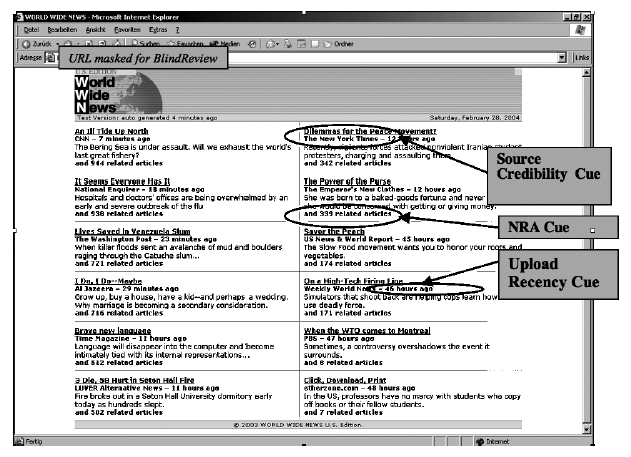
Figure - 1. Screen shot of the menu of news leads, with the three independent factors indicated
After browsing the news website for five minutes, they were taken to the study instruction page and subsequently to 12 news leads. Each news lead was on a separate page and had a questionnaire asking the subjects to evaluate the news item in the lead. Screen shot of the stimulus page with the news lead and the three manipulated variables are shown in Figure-2.
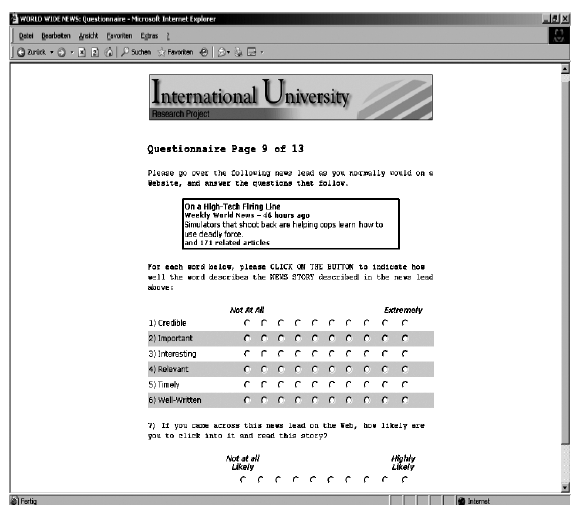
Figure - 2. Screen shot of a stimulus page with a news lead containing the three manipulated variables, followed by the battery of independent measures.
RESULTS
The first hypothesis, which predicted higher message credibility for high-credibility over low-credibility sources, did not receive direct support in our data because the main effect for the Source Credibility cue was not statistically significant. H2 received partial support in that the NRA main effect, while significant, did not show the predicted monotonic linear pattern.
In the ANOVA with perceived newsworthiness, the lone significant effect was a main effect for NRA, F (5, 5674) = 21.86, p < .001, such that when the number of related articles was either lowest (single digits) or highest (900+), participants rated the news item as more newsworthy than when it was anywhere in between the two extremes (see Figure 3 and Table 1). This meant partial support for H3.
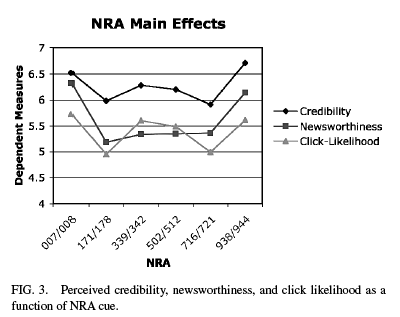
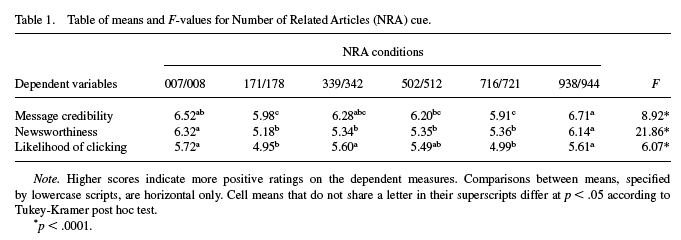
The ANOVA with the perceived-likelihood-of-clicking measure also yielded a single significant effect, again a main effect for NRA, F (10, 5674) = 6.07, p < .001, wherein the extreme and the middle conditions were associated with higher scores than the remaining two conditions (see Figure 3 and Table 1), thus providing partial support for H4.
The interaction between NRA and source credibility was also significant, F (5, 5674) = 2.32, p < .05. As can be seen in Figure 4, High Source Credibility was associated with higher ratings of message credibility than Low Source Credibility, except when the NRA cue was at its highest point. That is, when the number of related articles is really large (900+), the source credibility cue ceases to influence message credibility.
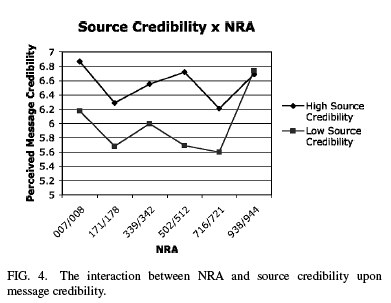
The 2-way interaction between source credibility and upload recency, F (2, 5674) = 6.33, p < .01, showed that while message credibility did not vary as a function of upload recency in the case of news items attributed to High Credibility sources, it did show a V-shaped effect in the case of items attributed to Low Credibility sources, with moderate recency registering the lowest score on message credibility (see Figure 5).
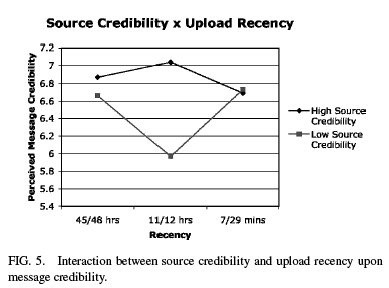
Perceived newsworthiness did not show a significant differentiation as a function of upload recency, F (2, 5674) = 0.06, p > .05, counter to the prediction made by H5.
SUMMARY
In summary, source credibility emerges as a powerful cue affecting participants’ perception of message credibility. In general, high source-credibility tends to over-ride considerations of recency and number of related articles in dictating one’s perceptions of message credibility. However, when the source credibility is low, these other cues become important in their contributions to our judgment of message credibility. The other consistent finding is that the NRA cue has a clearly bipolar effect pattern, with the extremes (i.e., very few and very large numbers of related articles—single digits and 900+) contributing to higher estimations of message credibility, newsworthiness, and click-likelihood than the intermediate conditions. Upload recency as a cue does not appear to have much of an effect on the perceptions measured in this study.
For more details regarding the study contact
Dr. S. Shyam Sundar by e-mail at sss12@psu.edu or by telephone at (814) 865-2173

